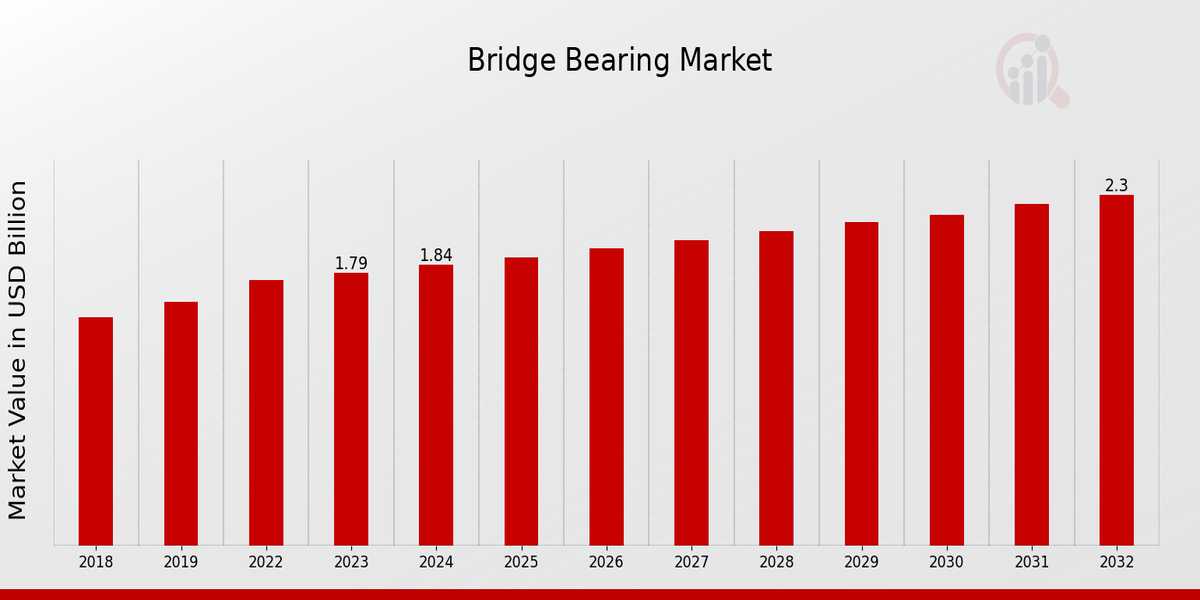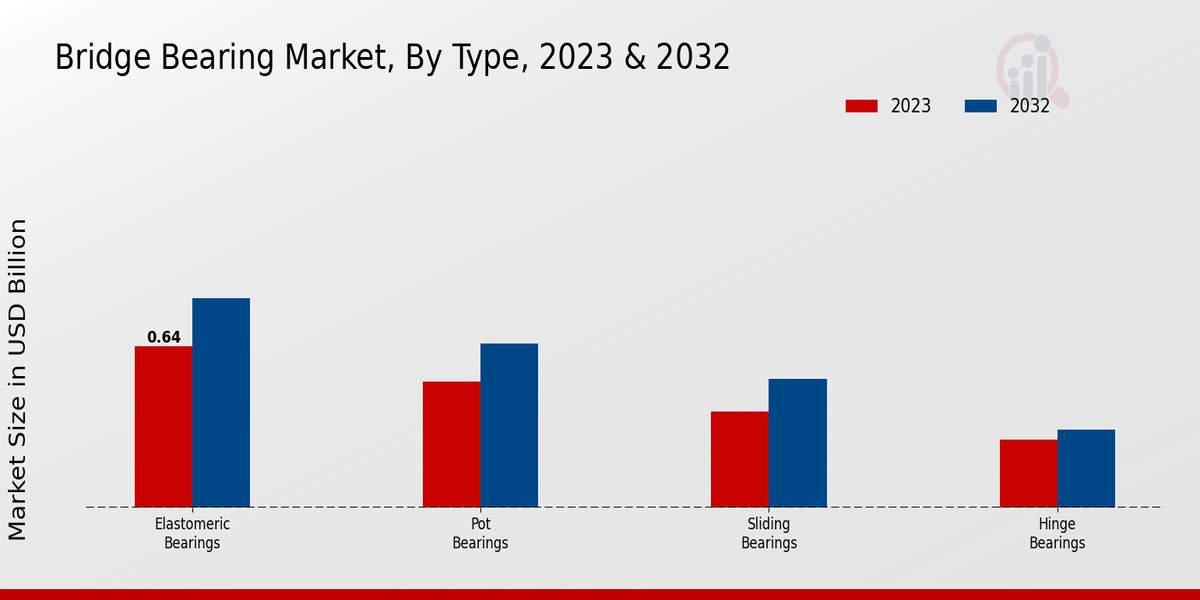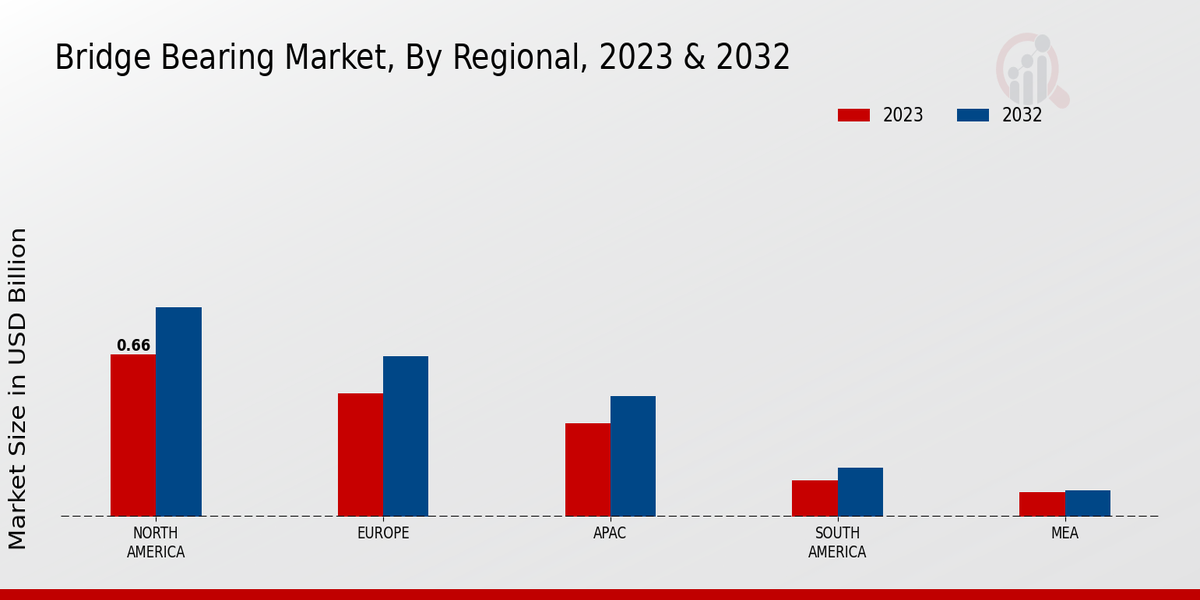Global Bridge Bearing Market Overview:
As per MRFR analysis, the Bridge Bearing Market Size was estimated at 1.89 (USD Billion) in 2024. The Bridge Bearing Market Industry is expected to grow from 1.95 (USD Billion) in 2025 to 2.50 (USD Billion) till 2034, at a CAGR (growth rate) is expected to be around 2.83% during the forecast period (2025 - 2034).
Key Bridge Bearing Market Trends Highlighted
The global bridge-bearing market is witnessing significant growth driven by the increasing demand for infrastructure development and the need for maintenance of existing structures. Urbanization and the rise in transportation networks, particularly in emerging economies, are pushing the need for reliable bearing solutions that support bridges and similar constructions.
Additionally, advancements in materials and technology are enhancing the durability and performance of bridge bearings, making them a preferred choice for engineers and construction firms. Sustainability is also influencing the market as more companies seek eco-friendly materials and solutions that reduce the environmental impact of construction activities.
Opportunities within the market are abundant, particularly as governments around the world invest in upgrading transportation infrastructures. There is potential for growth in the development of innovative bearing solutions that can withstand extreme weather conditions and heavy loads.
The shift toward modular construction methods presents another unique opportunity for manufacturers, as these systems often require specialized bearing types. Furthermore, the trend of digitalization in construction practices creates a space for companies that can integrate smart technologies into their products, offering better monitoring and maintenance solutions.
Recent trends show a notable increase in the adoption of advanced materials, such as rubber and composite materials, which enhance the performance and lifespan of bridge bearings. There is also a growing focus on research and development aimed at improving seismic resilience, especially in regions prone to earthquakes.
The market is also adapting to regulatory changes that prioritize safety and performance standards, creating a shift toward high-quality products. As the demand for safety in transportation continues to rise, the bridge bearing market is expected to evolve to meet these standards effectively, enhancing both performance and safety in infrastructure projects.

Source: Primary Research, Secondary Research, MRFR Database and Analyst Review
Bridge Bearing Market Drivers
Increasing Infrastructure Development Projects
The Global Bridge Bearing Market is poised for significant growth due to the ongoing and increasing investment in infrastructure development projects across the globe. Governments and private investors are focusing on enhancing transportation networks, which include bridges, highways, and railways.
These infrastructure projects are crucial for boosting local economies and improving connectivity between regions. As nations strive to modernize their infrastructure to accommodate growing populations and enhance trade routes, the demand for reliable and robust bridge bearings will become increasingly prominent.
Bridge bearings are essential components that support bridge structures and allow for movements caused by factors such as thermal expansion, vehicular loads, and seismic activities. The advancement in bridge engineering techniques and materials has allowed for the development of innovative bearing solutions that can withstand various environmental challenges.
Furthermore, the shift towards sustainable construction practices is leading to the use of eco-friendly materials in bridge-bearing production, which aligns with the global push for sustainability.
As a result, the increasing number of infrastructure development projects worldwide will undoubtedly fuel the growth of the Global Bridge Bearing Market in the coming years, providing new opportunities for manufacturers and suppliers to innovate and expand their offerings.
Technological Advancements in Bridge Bearing Solutions
The Global Bridge Bearing Market is experiencing a transformation driven by technological advancements.
Innovations in materials and manufacturing processes have led to the development of high-performance bridge bearings that offer superior durability and performance. These advancements are essential for meeting the challenges posed by modern engineering demands and environmental conditions.
Additionally, the incorporation of smart technologies allows for real-time monitoring of bridges, ensuring timely maintenance and extending the lifespan of bridge-bearing systems.
Rising Urbanization and Traffic Congestion
Urbanization is accelerating globally, leading to increased traffic congestion and the need for existing infrastructure to be upgraded or replaced. The Global Bridge Bearing Market is benefiting from this trend as older bridges require modern bearing systems to handle increased loads and dynamic conditions.
As cities expand and populations grow, safe and reliable transport infrastructure becomes critical, further driving the demand for advanced bridge-bearing technologies.
Bridge Bearing Market Segment Insights:
Bridge Bearing Market Type Insights
The Global Bridge Bearing Market has shown significant potential in recent years, with various types contributing to its overall valuation. The segment encompasses several essential types, including Elastomeric Bearings, Pot Bearings, Sliding Bearings, and Hinge Bearings, each playing a vital role in ensuring the structural integrity and longevity of bridges.
Among these, Elastomeric Bearings dominated the market, with values of 0.64 USD Billion in 2023 and expected to rise to 0.83 USD Billion by 2032. This type is favored for its ability to accommodate vibrations and displacements effectively, making it a significant choice for many bridge projects.
Pot Bearings followed closely, contributing a substantial value of 0.5 USD Billion in 2023, which is projected to grow to 0.65 USD Billion by 2032. Their ability to handle vertical and horizontal movements makes them essential for larger spans, enhancing their importance in the Global Bridge Bearing Market statistics.
Sliding Bearings, valued at 0.38 USD Billion in 2023 and expected to reach 0.51 USD Billion by 2032, highlighted the need for structures to manage movements associated with temperature variations and seismic activities. While they hold a smaller share compared to Elastomeric and Pot Bearings, their role in specific applications justifies their market presence.
Lastly, Hinge Bearings represented the smaller end of the spectrum, with a value of 0.27 USD Billion in 2023, with expectations to rise to 0.31 USD Billion by 2032. Although they contribute less to the overall market valuation, their function in accommodating rotational movements is crucial for certain bridge designs, making them relevant within the Global Bridge Bearing Market.
The segmentation within the market reflects a variety of engineering needs influenced by factors such as load conditions and environmental stressors. Thus, each type not only contributes to market diversity but also presents growth opportunities as infrastructure development continues to expand globally.
Drivers such as urbanization and the need for infrastructure upgrades further support the growth of this market, presenting a favorable environment for all types of bearings involved in bridge engineering.

Source: Primary Research, Secondary Research, MRFR Database and Analyst Review
Bridge Bearing Market Material Insights
The Global Bridge Bearing Market shows a steady growth trajectory, particularly within the Material segment, which plays a crucial role in ensuring the structural integrity and durability of bridges. This segment includes various materials such as Rubber, Steel, Polymer, and Composite, each contributing uniquely to the overall performance of bridge bearings.
Rubber bearings, known for their flexibility and shock-absorbing capabilities, are widely utilized for their effectiveness in seismic applications, while Steel bearings possess high load-bearing capacity and durability, making them essential for heavy traffic bridges.
Polymer bearings, recognized for their corrosion resistance and lightweight nature, are gaining popularity in modern bridge designs, particularly in challenging environments. Composite materials, combining the benefits of different substances, are emerging as a significant option due to their strength-to-weight ratio and advanced performance features.
The continuous demand for infrastructure development and maintenance is expected to drive market growth, with advancements in material technology creating new opportunities for improving bridge-bearing performance.
Overall, the Global Bridge Bearing Market segmentation highlights the importance of material selection in enhancing the lifespan and safety of bridge structures, providing valuable insights for industry stakeholders.
Bridge Bearing Market Application Insights
The Global Bridge Bearing Market shows a steady growth trajectory with applications across various sectors, including Highway Bridges, Railway Bridges, Pedestrian Bridges, and Industrial Bridges. Highway Bridges form a significant segment, primarily driven by increasing road infrastructure development and the rising number of vehicles.
Railway Bridges are equally important, facilitating effective transportation, which contributes substantially to the overall market growth. Pedestrian Bridges cater to urban development and safety, ensuring a significant share of the market due to heightened safety regulations and urbanization trends.
Meanwhile, Industrial Bridges are essential for connecting facilities in the manufacturing and logistics sectors, thereby reinforcing their prominence.
The segmentation within the Global Bridge Bearing Market highlights the diverse applications and the subsequent revenue implications, with key trends influencing each segment's dynamics and fostering opportunities for innovation and sustainability in bridge design and construction.
As the demand for robust infrastructure continues to rise, the market is expected to witness substantial growth, supported by ongoing advancements in construction technology and materials.
Bridge Bearing Market End Use Insights
The Global Bridge Bearing Market showcases diverse applications across the end use segments, significantly influencing its overall performance. Public infrastructure represents a vital area of focus, as it encompasses vital projects such as highways, railways, and urban transit systems, which require robust bridge-bearing solutions to ensure structural integrity and longevity.
Private infrastructure is also important, comprising residential and commercial projects, where the need for efficient load distribution and flexibility in design enhances its market presence.
Moreover, industrial applications are integral to the market, offering bridge bearings that are specially engineered for heavy-duty use in commercial settings. These segments collectively drive the demand for innovative solutions and cater to the evolving infrastructure landscape.
The market growth is bifurcated due to increasing urbanization and governmental investment in infrastructure, ultimately positioning the Global Bridge Bearing Market for steady expansion in the coming years, supported by an optimistic outlook and evolving construction methodologies.
Bridge Bearing Market Regional Insights
North America dominated this segment, holding a majority share valued at 0.66 USD Billion in 2023, reflecting robust infrastructure development and investment in transportation projects. Europe followed closely, with a valuation of 0.5 USD Billion in 2023, driven by advancements in bridge construction technologies and sustainable practices.
The APAC region, valued at 0.38 USD Billion, presents considerable growth potential due to rapid urbanization and increasing government expenditure on infrastructure.
South America, holding a value of 0.15 USD Billion, faced challenges such as economic fluctuations but shows promise with emerging projects. Meanwhile, the MEA segment, valued at 0.1 USD Billion, was characterized by limited infrastructure investments but is gradually recognizing the vital role of bridge-bearing solutions in enhancing transport reliability.
Key trends such as technological advancements and increased demand for durable materials are driving growth across these regions, thereby influencing the overall Global Bridge Bearing Market revenue.

Source: Primary Research, Secondary Research, MRFR Database and Analyst Review
Bridge Bearing Market Key Players and Competitive Insights:
The Global Bridge Bearing Market presents a complex landscape of competition, with numerous firms vying for significant market share through technological innovations and sustainable solutions. Various players in the market are capitalizing on the increasing demand for efficient and durable bridge bearing systems fueled by infrastructural development and maintenance projects across the globe.
Established firms are leveraging advanced materials and engineering practices to enhance product performance and meet evolving regulatory standards. With ongoing investments in research and development, companies are focused on improving the longevity and robustness of bridge bearings while also addressing environmental concerns that influence purchasing decisions.
In this context, understanding the strengths and competitive positioning of key players becomes essential for stakeholders looking to navigate this dynamic market environment effectively.
Wacker Neuss has carved out a strong presence in the Global Bridge Bearing Market, recognized for its commitment to quality and innovation. The company stands out due to its extensive portfolio of bridge-bearing solutions that cater to various structures, providing critical support and easing stress on load-bearing elements.
Wacker Neuss benefits from its advanced manufacturing techniques that bolster the durability and efficiency of its products, satisfying the increasing demand for reliable infrastructure components. Additionally, the company's emphasis on customer collaboration allows it to tailor its offerings to specific project requirements, enhancing its reputation among contractors and engineers.
This adaptability, coupled with his strong distribution network, positions Wacker Neuss as a formidable player in the Global Bridge Bearing Market.
Mott MacDonald is another influential entity in the Global Bridge Bearing Market, recognized for its engineering consultancy expertise and innovative solutions. The company leverages its extensive experience in bridge design and infrastructure projects to offer tailored guidance and support for selecting optimal bearing systems.
Mott MacDonald’s strengths lie in its comprehensive understanding of structural dynamics and the lifecycle cost implications of various bearing technologies, enabling it to provide clients with well-informed recommendations. Its proactive approach to incorporating sustainability and resilience into infrastructure engineering further bolsters its market position.
By fostering strong relationships with stakeholders and remaining at the forefront of technological advancements, Mott MacDonald continues to make a significant impact on the Global Bridge Bearing Market, emphasizing the importance of sound engineering practices in creating enduring, efficient infrastructure.
Key Companies in the Bridge Bearing Market Include:
-
Wacker Neuss
-
Mott MacDonald
-
SCHOMBURG
-
Rider
-
Kryton
-
Asahi Kasei
-
Trelleborg
-
Klein GmbH
-
The D.S. Brown Company
-
Hutchinson
-
Benson
-
C.C. Eastern
-
Bridgesource
-
Freyssinet
-
MEGASOLE
Bridge Bearing Market Developments
The Global Bridge Bearing Market has recently experienced significant developments, particularly in technological advancements aimed at improving the durability and performance of bridge bearings. Companies like Wacker Neuss and Trelleborg are focusing on innovative materials that enhance weather resistance and load distribution, addressing growing infrastructure demands.
Currently, there is a marked increase in government-funded infrastructure projects worldwide, which is driving demand for high-quality bridge bearings, further boosting market growth. In addition, the integration of sustainable practices within companies like Kryton and Asahi Kasei is increasingly influencing purchasing decisions among contractors who prioritize eco-friendly components.
There have also been notable mergers and acquisitions as organizations aim to consolidate their market positions and expand product offerings, although concrete details regarding specific transactions remain limited.
This consolidation trend signifies a competitive landscape where companies such as Hutchinson and MEGASOLE are intensifying their efforts to innovate and improve their operational capabilities. Additionally, valuations are on the rise, indicating a robust future outlook for the market as infrastructure investments evolve to meet urbanization demands.
Bridge Bearing Market Segmentation Insights
-
Bridge Bearing Market Type Outlook
-
Elastomeric Bearings
-
Pot Bearings
-
Sliding Bearings
-
Hinge Bearings
-
Bridge Bearing Market Material Outlook
-
Rubber
-
Steel
-
Polymer
-
Composite
-
Bridge Bearing Market Application Outlook
-
Highway Bridges
-
Railway Bridges
-
Pedestrian Bridges
-
Industrial Bridges
-
Bridge Bearing Market End Use Outlook
-
Public Infrastructure
-
Private Infrastructure
-
Industrial Application
-
Bridge Bearing Market Regional Outlook
-
North America
-
Europe
-
South America
-
Asia Pacific
-
Middle East and Africa
| Report Attribute/Metric |
Details |
|
Market Size 2024
|
1.89 (USD Billion)
|
|
Market Size 2025
|
1.95 (USD Billion)
|
|
Market Size 2034
|
2.50 (USD Billion)
|
|
Compound Annual Growth Rate (CAGR)
|
2.83% (2025 - 2034)
|
|
Report Coverage
|
Revenue Forecast, Competitive Landscape, Growth Factors, and Trends
|
|
Base Year
|
2024
|
|
Market Forecast Period
|
2025 - 2034
|
|
Historical Data
|
2019 - 2023
|
| Market Forecast Units |
USD Billion |
| Key Companies Profiled |
Wacker Neuss, Mott MacDonald, SCHOMBURG, Rider, Kryton, Asahi Kasei, Trelleborg, Klein GmbH, The D.S. Brown Company, Hutchinson, Benson, C.C. Eastern, Bridgesource, Freyssinet, MEGASOLE |
| Segments Covered |
Type, Material, Application, End Use, Regional |
| Key Market Opportunities |
Infrastructure development projects, Increasing adoption of sustainable materials, Technological advancements in bearing design, Growing demand for retrofitting solutions, Expanding urbanization and transportation networks |
| Key Market Dynamics |
Infrastructure development initiatives, Increasing demand for durable materials, Technological advancements in design, Environmental regulations and sustainability, Growing construction industry investments |
| Countries Covered |
North America, Europe, APAC, South America, MEA |
Frequently Asked Questions (FAQ) :
The Global Bridge Bearing Market is expected to be valued at approximately 1.95 USD Billion in 2025.
By 2034, the Global Bridge Bearing Market is projected to reach a value of 2.50 USD Billion.
The expected CAGR for the Global Bridge Bearing Market from 2025 to 2034 is 2.83%.
North America is anticipated to dominate the Global Bridge Bearing Market with a projected value of 0.85 USD Billion in 2032.
The Elastomeric Bearings segment is projected to be valued at 0.83 USD Billion by 2032.
Key players in the Global Bridge Bearing Market include Wacker Neuss, Mott MacDonald, and The D.S. Brown Company.
The expected market size for Pot Bearings in 2024 is approximately 0.52 USD Billion.
The APAC region is anticipated to grow to a market value of 0.49 USD Billion by 2032.
The Sliding Bearings segment is expected to grow to 0.51 USD Billion by 2032.
Challenges such as regulatory changes and competition can impact the growth of the Global Bridge Bearing Market.

















